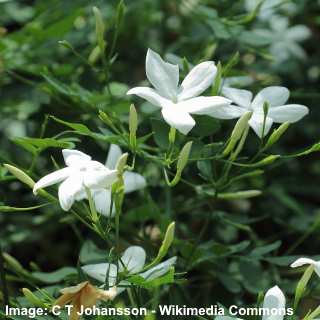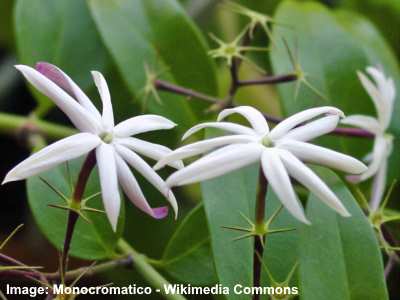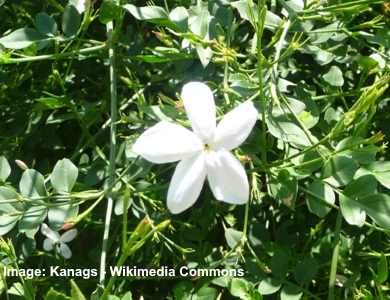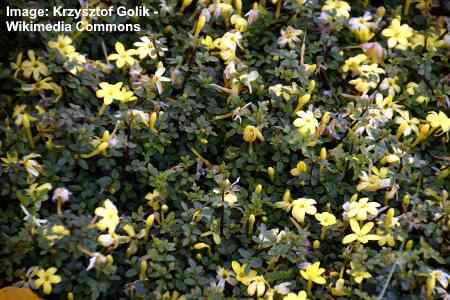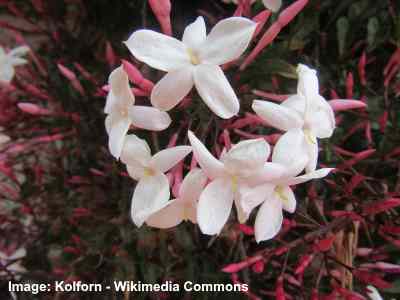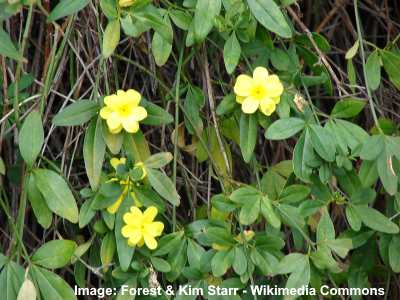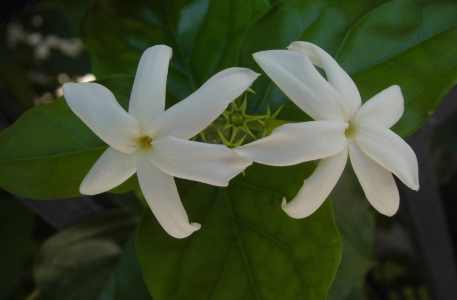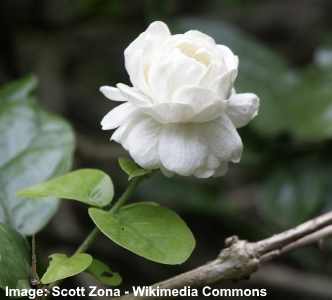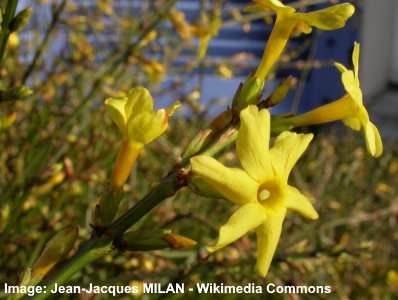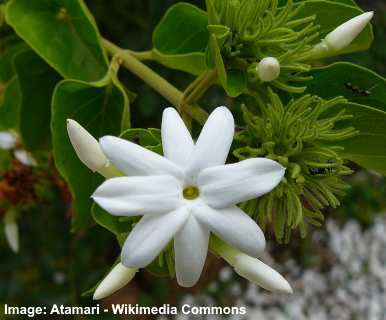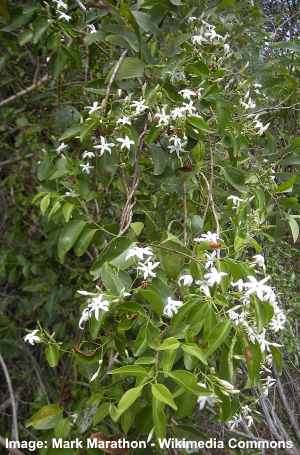Types of Jasmine Flowers: Amazing Varieties of Jasmine Plants and Their Flowers

Jasmine flowers are well known for their pure white color and wonderful scent. Jasmine is a type of fragrant shrub or vine in the Oleaceae family that belongs to the Jasminum genus. This means that jasmine is in the same subgroup as olive, lilac, and forsythia plants.
There are about 200 species of jasmine shrubs and vines. Most of them are native to tropical and warmer climates in Asia and Oceania but are now cultivated in many other parts of the world.
Jasmine plants are characterized by their small fragrant white or yellow flowers. The jasmine plant flowers from the spring until fall. Its dark green foliage contrasting with pure white or yellow flowers make the plant a beautiful addition to any garden or even as a houseplant growing in an indoor container.
Jasmine plants require full sun to partial shade to grow well. The soil should be kept moist but well-drained. If you want to keep jasmine as a shrub, then some pruning is required. However, if you want to decorate arbors, trellises, or pergolas, then little maintenance is needed.
If you want to grow jasmine indoors in a container, you will need to place your indoor jasmine plant in a partly sunny area to encourage vigorous and healthy growth. When the jasmine plant grows taller indoors, you will need a trellis to support its growth as well as pruning it regularly to control its growth.
Jasmine can be either deciduous, such as winter jasmine, or evergreen, like the Arabian jasmine. Some jasmine species are more cold hardy than others with winter jasmine the most cold hardy. Tender jasmines, such as Angel Wing jasmine, need temperatures above 40°F (4.5°C) to thrive.
Common jasmine is the most popular species of jasmine and one of the most fragrant of the jasmine varieties. However, other types of jasmine fragrant bush include Royal Jasmine, Arabian Jasmine, Italian Jasmine, and even Pink Jasmine.
In this article, you will find out how to identify features of many jasmine species.
Types of Jasmine Flowers (With Pictures and Names)
Let’s look in more detail as some of the identifying characteristics of the different kinds of jasmine shrubs and vines. The following list of jasmine plants includes pictures of jasmine flowers and scientific name of each type.
Common Jasmine (Jasminum officinale)
Common jasmine (Jasminum officinale) is the most commonly grown type of jasmine in the world. It is a fast-growing semi-evergreen or deciduous climbing vine. It has pure white flowers that give off a wonderfully heady aroma.
Other names for common jasmine include ‘summer jasmine,’ ‘white jasmine,’ and ‘poet’s jasmine.’
Usually, common jasmine starts flowering in late spring and continues until fall. Flowers grow in clusters on the plant and each pretty flower has 5 petals. The aromatic white flowers in these clusters measure around 1” (2.5 cm) wide.
The foliage of common jasmine is green fuzzy leaves that are arranged like a feather (pinnate) on the stems. These leaves taper to a point.
Because of its vigorous climbing habits, common jasmine is good for covering trellises, arbors, or walls. You can also use jasmine as a low-growing ground cover plant or grow it in containers. This type of jasmine can grow up to between 15 and 30 ft. (4.5 – 9 m) and has a spread of up to 15 ft. (4.5 m).
Grows well in zones 7 – 10.
Angel Wing Jasmine (Jasminum nitidum)
Angel Wing jasmine (Jasminum nitidum) has some of the prettiest flowers from all of the jasmine species. Similar to common jasmine, Angel Wing jasmine is a vigorous climbing vine with wonderfully scented white flowers.
Other names for this jasmine shrub include ‘Star jasmine,’ ‘Shining jasmine,’ and ‘Pinwheel jasmine.’ All of these names refer to some identifying feature of this jasmine plant.
The large ivory-white flowers of Angel Wing jasmine have long thin petals that fan out to look like white rays. These dainty flowers can grow to about 2” (5 cm) across and have aroma common to jasmine. Like with many jasmine shrubs, Angel Wing jasmine flowers grow in clusters and bloom from late spring until the end of summer. The flowers have purple undersides which make this a particularly ornamental plant.
One of the identifying features of this jasmine species is its glossy green leaves.
Angel Wing jasmine isn’t as cold hardy as common jasmine. Most people who grow Angel Wing jasmine outdoors prune it regularly to create a decorative container shrub. Its cascading vines, glossy leaves, and aromatic white flowers make for an attractive garden feature.
Grows well in zones 10 and 11.
Royal Jasmine (Jasminum grandiflorum)
Like most jasmine species, Royal jasmine (Jasminum grandiflorum) is a scrambling vine that has pretty white flowers. Other names for Royal jasmine include ‘Spanish Jasmine,’ and ‘Catalan jasmine.’
Compared to common jasmine, this type of jasmine has a more shrub-like nature and it doesn’t grow as tall. The trailing vines of Royal jasmine usually grow to between 2 and 4 ft. (0.6 – 1.2 m).
Royal jasmine flowers are similar to the ‘common’ variety. Each flower consists of pure white petals in an open star shape. The flowers grow in abundant clusters and are so numerous that the bush can look almost white. When in full bloom in the summer, the flowers produce an aromatic scent that fills the air.
Due to the unique sweet scent of the Royal jasmine flowers, it is often the species used for jasmine aroma. In some countries, Royal jasmine is used in perfumes and also to flavor tea.
Grows well in zones 7 – 10.
Dwarf Jasmine (Jasminum parkeri)
Dwarf jasmine (Jasminum parkeri) is an excellent choice to grow in a small garden or in containers. Dwarf jasmine is a small evergreen shrub that only reaches a height of 1 ft. (30 cm) and has a moderate spreading nature.
Apart from its small size, one of the identifying features of dwarf jasmine is its bright yellow flowers. These dainty flowers are made up of 5 yellow lobes or petals. You can expect an abundance of these yellow jasmine flowers from spring until the fall.
One difference between dwarf jasmine and most other jasmine varieties is the size of leaves. Small oval leaves grow on short stems giving the dwarf jasmine plant a compact look. Dwarf jasmine isn’t as aromatic as other varieties; however, you still get aromas of jasmine from it.
Use dwarf jasmine as a colorful ground cover plant or plant it in containers. You can also prune the jasmine shrub into various ornamental shapes. Dwarf jasmine is also grown to use in cut flower displays for its dainty foliage and sun-yellow flowers.
Grows well in zones 7 – 10.
Wild Jasmine (Jasminum parkeri, Jasminum angustifolium)
Wild jasmine is also called common yellow jasmine (Jasminum fruticans) and is a small shrub with fragrant yellow flowers and small glossy leaves. Wild jasmine is not a trailing type of jasmine but grows into a dome shape about 6.5 ft. (2 m) high. Its bright yellow flowers are tubular and look like a small trumpet. You can expect common yellow jasmine to flower in mid-summer to late fall.
Unlike common jasmine, yellow wild jasmine has small oval glossy leaves that grow abundantly on the stems.
One of the advantages of growing wild jasmine is that it is a cold-hardy type of jasmine. This evergreen shrub can survive well in cooler climates and in some places is a semi-evergreen plant. You can train the plant to provide good ground cover or let it grow into an attractive hedge.
Another plant referred to as ‘wild jasmine’ is Jasminum angustifolium. This flowering climbing plant produces large clusters of white flowers and has large glossy leaves.
Grows well in zones 6b – 10.
Pink Jasmine (Jasminum polyanthum)
Pink jasmine (Jasminum polyanthum) is a very decorative type of climbing vine. The name ‘pink jasmine’ comes from the abundance of pink buds that decorate this shrubby vine. Its 5-petal white flowers with the pinkish buds give this type of jasmine an exotic, oriental appearance.
Pink jasmine has an intense aroma when it flowers from early spring until fall. The pretty white flowers sit on the end of light pink tubes. Each flower measures 1” (2.5 cm) across and, similar to common jasmine, they grow in large clusters.
One of the features of Pink jasmine is its intense fragrance. The large number of flowers on this climbing vine just add to the intensity of scent it produces. From all of the jasmine cultivars available, pink jasmine is one of the largest. This fast-growing vine can reach heights of up to 20 ft. (6 m). This means it is an excellent plant for aromatic floral ground cover or to decorate arbors or trellises.
You can expect pink jasmine plant to flower in winter and early spring. If you live in warm climates, you may even find that your pink jasmine blossoms all year long.
Grows well in zones 9 – 10.
Italian Jasmine (Jasminum humile)
Native to Asia, (Jasminum humile) is a type of yellow jasmine. Italian jasmine is a semi-evergreen shrub that can grow to between 8 and 13 ft. (2.5 – 4 m). The woody stems grow more like a shrub rather than trailing vines.
An interesting feature of Italian jasmine is the shape of its pretty bright yellow tubular flowers. Each one is a long tube-like flower with 5 petals that fan out at the end. These tubular flowers grow in small clusters and droop down like tiny bells, and look quite stunning against the dark green thick leaves.
Flowers on Italian jasmine can be either single flowers or showy double flowers. You can expect an abundance of blooms in spring and summer as well as powerful jasmine aromas to fill your garden with fragrant air.
One of the reasons Italian jasmine is popular is because it is easy to grow even in cold climates. This cold-hardy type of jasmine may keep its leaves even in cold winters. After the frost has gone, you will be rewarded with beautiful yellow fragrant blooms in early spring until the end of summer.
Grows well in zones 7 – 11. May need some protection in very cold winters.
Primrose (Japanese) Jasmine (Jasminum mesnyi)
Primrose jasmine (Jasminum mesnyi) is another type of jasmine with yellow flowers. Compared to other jasmine plants, the flowers on Primrose jasmine tend to be much larger.
Primrose jasmine is also called Japanese jasmine, and is a scrambling type of jasmine vine that grows well in warm climates. It is cold sensitive and isn’t tolerant to frost. The climber can reach heights of 10 ft. (3 m) and has a spread of between 3 and 7 ft. (1 – 2).
Because Primrose jasmine is a vigorous climber, you will need to prune it regularly to maintain it.
Grows well in zones 8 – 11.
Arabian Jasmine (Jasminum sambac)
Arabian jasmine (Jasminum sambac) has the classic jasmine aroma and is the main species used to flavor jasmine tea. The intensely fragrant star-shaped white flowers and glossy leaves can grace any garden.
Arabian jasmine is a creeping type of evergreen jasmine shrub that thrives in warm climates. Large glossy leaves grow on the vines which contrast with the pure white clusters of large flowers. There can be 3 to 12 flowers in each cluster. Each flower can measure around 1” (2.5 cm) across and gives off an intense fragrance. As the flowers mature, they change from brilliant white to light pink.
Arabian jasmine grows to an average height for a climber. You can expect the vine to reach a height of between 6 and 10 ft. (1.8 – 3 m). You can also grow the trailing vines as ground cover where they will provide a carpet of snow-white blossoms in the summer.
Grows well in zones 9 – 12.
Arabian Jasmine ‘Grand Duke of Tuscany’
The ‘Grand Duke of Tuscany’ jasmine shrub is one of the showiest and most beautiful types of jasmine flowers. This is an Arabian jasmine (Jasminum sambac) cultivar that is as fragrant as it is beautiful.
The most striking feature of the ‘Grand Duke of Tuscany’ is its large white double bloom flowers. These jasmine flowers look more like roses than typical jasmine flowers. The fragrant blossoms are comprised of ruffled petals that give them a bushy look. The deep green ruffled leaves also add to the attractive appearance of this Arabian jasmine plant.
Compared to other white jasmine species, the Arabian Jasmine ‘Grand Duke of Tuscany’ is a slow grower. It will grow to around 3 ft. (90 cm) maximum. Depending on your climate, this bushy shrub can flower all year long. However, in cooler climates the flowering season is during summer.
Grows well in zones 9 – 12.
Winter Jasmine (Jasminum nudiflorum)
Named ‘Winter jasmine’ due to its fragrant blooms in wintertime, this type of jasmine produces yellow, spiky-looking flowers. Winter jasmine (Jasminum nudiflorum) is a deciduous shrub that grows to a medium size. If the climate is right, this jasmine flowering shrub will transform your garden with bright yellow bushes.
You can grow winter jasmine as either a shrub or trailing vine. As a shrub, winter jasmine takes on a large sprawling bushy appearance that can be up to 4 ft. (1.2 m) tall. If you grow it as a vine, the creeping stems will reach up to 15 ft. (4.5 m).
Its slender green stems, dark green foliage, and lemon-yellow flowers look wonderful cascading over walls, growing up trellises, or decorating arbors.
Grows well in zones 6 – 9.
Indian Jasmine (Jasminum multiflorum)
Indian jasmine (Jasminum multiflorum) is an especially elegant type of jasmine plant with snow-white flowers. Other names include ‘Star jasmine,’ ‘Winter jasmine,’ and ‘Downy jasmine.’
Indian jasmine is a jasmine variety that flowers in the winter and grows average-sized star-shaped flowers. Each pretty flower has 8 petals that fan out from the center.
Unlike many other jasmine species, Indian jasmine flowers don’t have any notable fragrance. However, its beauty as it flowers between November and February make up for any lack of scent.
Indian jasmine is a fast-growing climbing plant that can quickly reach heights of up to 10 ft. (3 m).
Grows well in zones 8a – 11b.
Stiff Jasmine (Jasminum volubile)
Stiff jasmine (Jasminum volubile) is a type of jasmine native to Australia. Its twining vines can reach lengths of between 15 and 30 ft. (4.5 – 9 m) and it has large egg-shaped shiny leaves. Similar to Angel Wing jasmine, Stiff jasmine has dainty star-shaped white flowers that look like a pinwheel.
Grows well in zones 8b – 11.
Florida Jasmine (Jasminum floridum)
Native to China, the Florida jasmine (Jasminum floridum) is also called Showy Jasmine. This semi-evergreen to evergreen shrub is a type of drought tolerant and low maintenance jasmine shrub, and reaches to height and width of 3′ – 5′ (0.9 – 1.5 m). Its foliage is dark green with small yellow flowers.
Grows well in zones 6a – 10b.
Related: The Most Popular Flowers in The World
Are Jasmine Plants Toxic?
True jasmine plants from the Oleaceae family are not toxic to humans, dogs, cats and horses according to the ASPCA.
However there are several plants known as false jasmine that are toxic plants. False jasmine plants contain the word “Jasmine” in their name but they don’t belong to the Oleaceae family. These include Carolina jasmine and yellow jasmine which contain poisonous substances that are toxic to humans and animals.
Related articles:

